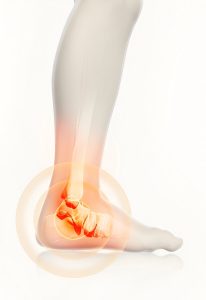Ankle Sprain Physiotherapy
Most people will sprain their ankle at least once in their life, more so for those who regularly engage in physical activities. An ankle sprain occurs when the strong ligaments that support the ankle stretch beyond their limits and tear. These injuries range from mild to severe, depending on the severity of the ligament damage. To learn how to best recover from an ankle sprain and reduce the risk of reinjury, let’s first understand the ankle anatomy.
Three Bones That Make Up The Ankle Joint
- Tibia: the major bone of the lower leg. It bears most of the body’s weight. Its bottom portion forms the medial malleolus, the inside bump of the ankle.
- Fibula: the smaller of the two bones in the lower leg. Its lower end forms the lateral malleolus, the outer bump of the ankle.
- Talus: the top bone of the foot.

Tendons: The Connective Tissue That Connects Muscles To Bones
Tendons are strong, flexible bands of connective tissue that anchor muscles to bones, playing a crucial role in maintaining joint stability and facilitating movement. In the ankle, several muscles and tendons work together to control motion and support your body during walking, running, and jumping. When these tendons are overstressed especially during an ankle sprain they can become irritated, stretched, or torn, leading to pain and inflammation.
If left untreated, an ankle sprain can cause lingering tendon issues, such as tendinitis. This is why proper sprained ankle treatment is essential. We often see patients struggling with ongoing discomfort from a previous sprained ankle, unaware that damaged tendons may be contributing to their pain.
The Major Ankle Ligaments
The ankle joint is composed of several bones and ligaments that hold them together. These fibrous bands of tissue are designed to provide mechanical reinforcement to the joint, increasing its stability and strength essential in preventing or recovering from an ankle sprain. The ligaments of the ankle are divided into three groups, one of which is the lateral ligaments.
The lateral collateral ligament (complex) of the ankle is a set of three ligaments that sit on the outside of the ankle. These ligaments work to resist inversion of the ankle joint, which is one of the most common causes of ankle sprains. The three ligaments are as follows:
- Anterior talofibular ligament (ATFL), which connects the front of the talus bone to the fibula, or shin bone
- The calcaneofibular ligament (CFL), which connects the calcaneus, or heel bone, to the fibula
- The posterior talofibular ligament (PTFL), which connects the rear of the talus bone to the fibula
Apart from the lateral collateral ligament, the medial collateral (deltoid) ligament is also a major ligament that helps support the ankle by giving reinforcement to the entire medial, or inner side of the ankle.
Out of these major ligaments, the most commonly injured is the anterior talofibular ligament, especially during a sprained ankle. Depending on the severity, sprained ankle treatment may involve rest, ice, elevation, or guided ankle sprain exercises to restore strength and stability. Placing high stress on any of these ligaments can cause them to stretch or tear, leading to painful sprained ankle movement and potentially prolonged recovery. Understanding how to cure a sprained ankle often starts with identifying which ligament is affected and choosing the right sprained ankle workout plan tailored for healing.
Common Causes Of Ankle Sprains
- Inversion injury
- Acute injury that forces the ankle joint beyond its normal range of motion, such as in a sports injury or falling off a curb
- Overuse injury caused by repetitive forces, such as repeated hard landings involved in sports, such as long-distance running and basketball
Common Signs & Symptoms
The symptoms of ankle sprains may include:
- Pain or soreness
- Swelling
- Bruising
- Difficulty walking
- Stiffness in the joint
Ankle fractures are common injuries most often caused by the ankle rolling inward or outward. Many people mistake an ankle fracture for an ankle sprain, but they are quite different and, therefore, will require an accurate and early diagnosis. They sometimes occur simultaneously. Be sure to get in touch with a physiotherapist to discover the potential foot and ankle problems that you may unwittingly have beyond ankle sprains.
What Should I Do When I Sprained My Ankle?
- Rest: Stay off the injured ankle. Walking may cause further injury.
- Ice: Apply an ice pack to the injured area, placing a thin towel between the ice and the skin. Apply ice to the area for 20 minutes with a 40-minute interval.
- Compression: An elastic wrap may be recommended to control swelling.
- Elevation: The ankle should be raised slightly above the level of your heart to reduce swelling.
- Medications: Nonsteroidal anti-inflammatory drugs (NSAIDs), such as ibuprofen, may be recommended to reduce pain and inflammation. In some cases, prescription pain medications are needed to provide adequate relief.
- Early physical therapy.
How Sprained Ankle Physiotherapy Can Help
Unfortunately, a sprained ankle can increase your risk of reinjury by as much as 40-70%. But with the correct post-injury rehabilitation exercises, this risk can be significantly reduced.
Several sprained ankle physiotherapy treatments need to be employed to effectively rehabilitate your sprained ankle and prevent a recurrence.
- Strengthening and proprioceptive exercises are strongly supported by research in their ability to reduce pain, returning to sport quickly, and preventing further reinjury.
- Mobilisation and manual therapy have also proven to improve range of motion and reduce pain in the short term, and are good additions to rehabilitation (alongside exercises).
- Taping and bracing have also shown to be effective in reducing future injuries.
In more severe cases, surgery may be required to adequately treat an ankle sprain. Surgery often involves repairing the damaged ligament(s). The foot and ankle surgeon will select the surgical procedure best suited for your case based on the type and severity of your injury as well as your activity level.

